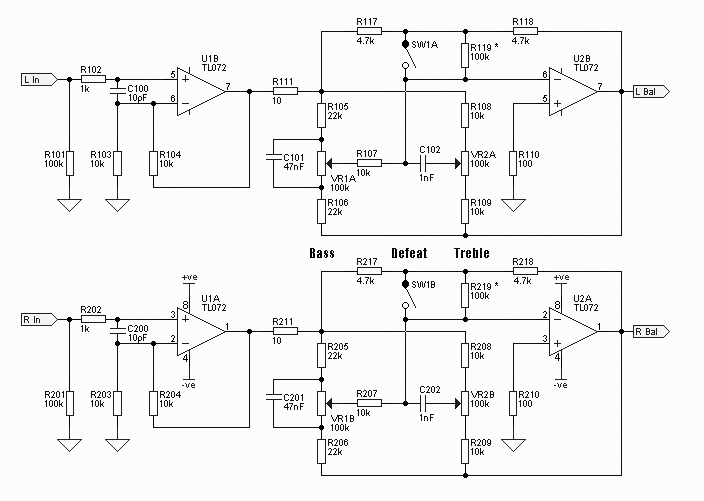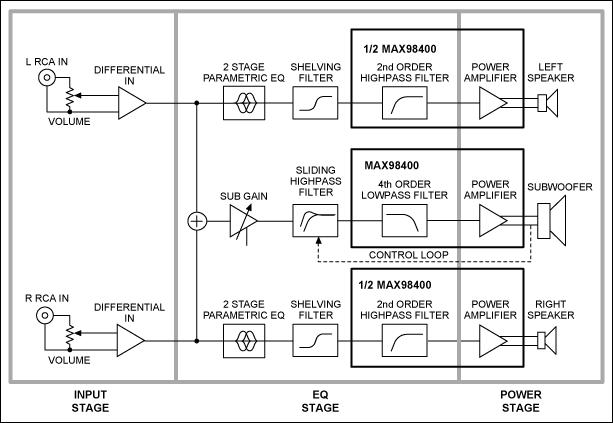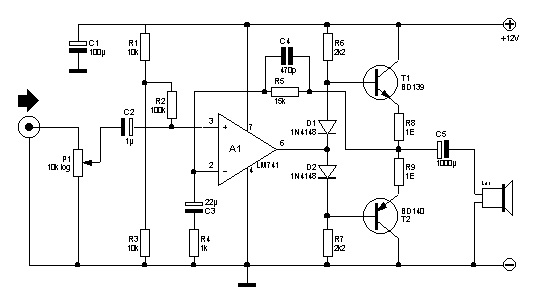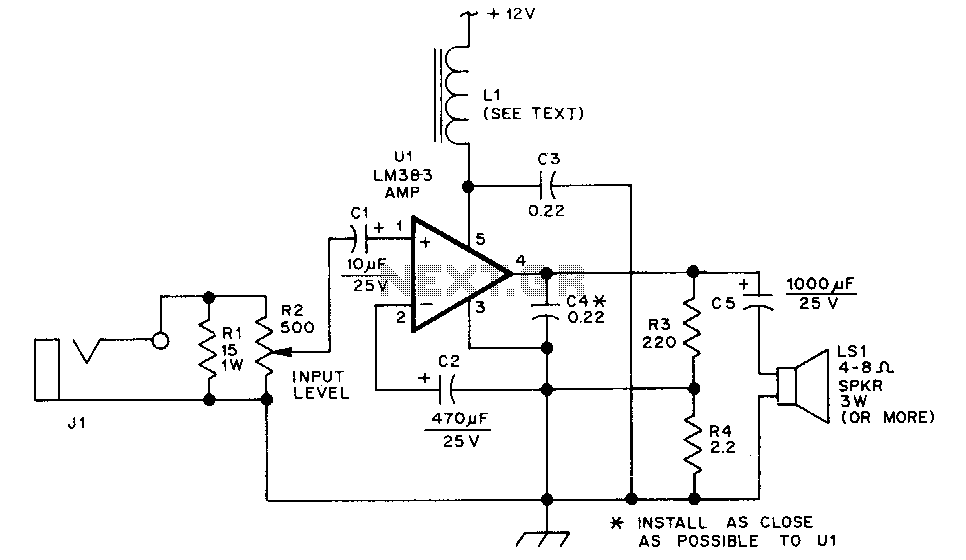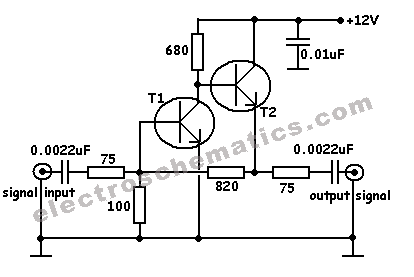
Difficulty with Common Emitter Amplifier
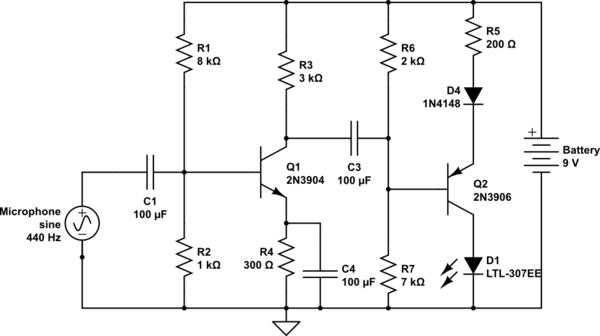
The circuit takes input from a microphone to power an LED, which remains off in ambient sound conditions and brightens with increasing noise levels. The peak voltage produced by the microphone is proportional to the sound levels. The microphone outputs a maximum of 80mV at the loudest sound. The LED begins to illuminate at 1.8V and reaches maximum brightness at 2.2V. The transistor used in the circuit activates when the base-emitter voltage (V_be) exceeds 0.6V. There was confusion regarding the grounding in the circuit, as the microphone is shown connected to a ground symbol without indicating other nodes connected to ground, complicating the understanding of the circuit's intent. Modifications were made based on feedback, resulting in the LED's current varying at 440Hz, ranging from 3.84mA to 4.61mA, with minimal voltage variation across the LED and capacitor (~10mV per cycle). The maximum voltage at the emitter is 930mV.
The circuit design utilizes a microphone as a sound sensor, converting acoustic energy into an electrical signal. The microphone's output is then processed to control the brightness of an LED. This is achieved by connecting the microphone to a transistor, which acts as a switch. The transistor is configured so that it turns on when the base-emitter voltage exceeds 0.6V, allowing current to flow through the LED.
To ensure proper operation, the microphone output should be coupled to the base of the transistor through a resistor network that sets the gain and input impedance. A capacitor may also be included in the circuit to filter out noise and stabilize the voltage fluctuations caused by ambient sounds. The LED is connected to the collector of the transistor, allowing it to light up when the transistor is activated.
The LED operates within a specific voltage range, only illuminating when the voltage exceeds 1.8V and reaching peak brightness at 2.2V. It is crucial to ensure that the circuit is designed to accommodate these voltage levels. The feedback from users indicated that the LED's current varies at a frequency of 440Hz, which suggests that the circuit may be picking up audio signals or oscillations in the environment.
The emitter voltage measurement of 930mV indicates that the transistor is operating in a region where it is partially on, which may affect the brightness of the LED. Careful attention should be paid to the resistor values in the circuit to ensure that the LED receives sufficient current without exceeding its maximum rating.
In summary, the circuit serves as a sound-activated LED driver, with the microphone providing the input signal, the transistor controlling the output based on the sound level, and the LED providing a visual indication of the detected sound intensity. Proper grounding and component selection are essential for optimal performance.Take the input from a microphone and use it to power an LED, so that it`s off at ambient sound, and (the peak brightness) gets brighter with noise level. It`s okay if it flickers, I`m just trying to get the peak voltage to be proportional to sound levels.
What I know: - The loudest sound I use causes the microphone to emit 80mV - The LED faintly lights at 1. 8 V - The LED maxes out at 2. 2 V - The transistor I`m using activates when V_be > 0. 6 V You show the microphone connected to a "ground" symbol, but you don`t show any other node in the circuit also connected to ground. This makes it difficult figure out what your intent is. The circuit would probably work if you connect it to the junction of R2 and RE. Dave Tweed™ Apr 17 `13 at 2:09 Alright, I`ve made the modifications that @DaveTweed and Peter Bennett mentioned, and now: the LED`s current varies at 440Hz, from 3.
84 to 4. 61 mA, and the voltage at the LED and capacitor vary very little (~10 mV per cycle). The voltage at the emitter is low, at max 930 mV. Hopefully this is enough information for troubleshooting. :/ I can link the simulator I`m using, if that helps Henry Swanson Apr 17 `13 at 2:34 🔗 External reference
The circuit design utilizes a microphone as a sound sensor, converting acoustic energy into an electrical signal. The microphone's output is then processed to control the brightness of an LED. This is achieved by connecting the microphone to a transistor, which acts as a switch. The transistor is configured so that it turns on when the base-emitter voltage exceeds 0.6V, allowing current to flow through the LED.
To ensure proper operation, the microphone output should be coupled to the base of the transistor through a resistor network that sets the gain and input impedance. A capacitor may also be included in the circuit to filter out noise and stabilize the voltage fluctuations caused by ambient sounds. The LED is connected to the collector of the transistor, allowing it to light up when the transistor is activated.
The LED operates within a specific voltage range, only illuminating when the voltage exceeds 1.8V and reaching peak brightness at 2.2V. It is crucial to ensure that the circuit is designed to accommodate these voltage levels. The feedback from users indicated that the LED's current varies at a frequency of 440Hz, which suggests that the circuit may be picking up audio signals or oscillations in the environment.
The emitter voltage measurement of 930mV indicates that the transistor is operating in a region where it is partially on, which may affect the brightness of the LED. Careful attention should be paid to the resistor values in the circuit to ensure that the LED receives sufficient current without exceeding its maximum rating.
In summary, the circuit serves as a sound-activated LED driver, with the microphone providing the input signal, the transistor controlling the output based on the sound level, and the LED providing a visual indication of the detected sound intensity. Proper grounding and component selection are essential for optimal performance.Take the input from a microphone and use it to power an LED, so that it`s off at ambient sound, and (the peak brightness) gets brighter with noise level. It`s okay if it flickers, I`m just trying to get the peak voltage to be proportional to sound levels.
What I know: - The loudest sound I use causes the microphone to emit 80mV - The LED faintly lights at 1. 8 V - The LED maxes out at 2. 2 V - The transistor I`m using activates when V_be > 0. 6 V You show the microphone connected to a "ground" symbol, but you don`t show any other node in the circuit also connected to ground. This makes it difficult figure out what your intent is. The circuit would probably work if you connect it to the junction of R2 and RE. Dave Tweed™ Apr 17 `13 at 2:09 Alright, I`ve made the modifications that @DaveTweed and Peter Bennett mentioned, and now: the LED`s current varies at 440Hz, from 3.
84 to 4. 61 mA, and the voltage at the LED and capacitor vary very little (~10 mV per cycle). The voltage at the emitter is low, at max 930 mV. Hopefully this is enough information for troubleshooting. :/ I can link the simulator I`m using, if that helps Henry Swanson Apr 17 `13 at 2:34 🔗 External reference
